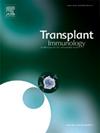Transcriptomics-based identification of biomarkers associated with mast cell activation during ischemia-reperfusion injury in kidney transplantation
IF 1.6
4区 医学
Q4 IMMUNOLOGY
引用次数: 0
Abstract
Background
Ischemia-reperfusion injury (IRI) in kidney transplantation can delay graft function recovery and increase the risk of rejection. Mast cell activation releases various bioactive mediators that exacerbate renal IRI. Assessing mast cell activation may be crucial for managing IRI after kidney transplantation.
Methods
We analyzed the dataset GSE43974 from the Gene Expression Omnibus (GEO) to evaluate immune cell infiltration during the IRI phase of kidney transplantation using the CIBERSORT algorithm. Weighted gene co-expression network analysis (WGCNA) was performed to identify genes most strongly correlated with mast cell activation. Hub genes were identified using protein-protein interaction (PPI) network analysis and machine learning algorithms. Model accuracy for identifying hub genes was assessed using receiver operating characteristic (ROC) curve calibration. Clinical utility was evaluated through decision curve analysis (DCA). Correlation analysis was conducted to explore associations between the selected hub genes and immune cell infiltration. Additionally, a hub gene–miRNA regulatory network was constructed.
Results
Mast cell activation exhibited the most significant variation among graft-infiltrating immune cells during IRI. WGCNA identified 115 genes closely associated with mast cell activation, from which three hub genes—JUN, MYC, and ALDH2—were selected using a PPI network and machine learning approach. A diagnostic model based on these three genes demonstrated high accuracy, as validated by the Hosmer-Lemeshow test (P = 0.980) and an area under the ROC curve (AUC) of 1. DCA indicated that these hub genes had strong clinical decision-making relevance, while correlation analysis confirmed their associations with multiple immune cell types. Finally, a hub gene–miRNA network provided a theoretical framework for the regulatory mechanisms of the three genes.
Conclusion
JUN, MYC, and ALDH2 may serve as biomarkers of mast cell activation during IRI in kidney transplantation. Further studies are warranted to explore their potential in mitigating IRI.
基于转录组学的肾移植缺血再灌注损伤中肥大细胞活化相关生物标志物鉴定
肾移植的缺血再灌注损伤(IRI)会延迟移植功能的恢复,增加排斥反应的风险。肥大细胞激活释放各种生物活性介质,加剧肾脏IRI。评估肥大细胞活化可能是处理肾移植后IRI的关键。方法对GEO数据集GSE43974进行分析,采用CIBERSORT算法评估肾移植IRI期免疫细胞浸润情况。加权基因共表达网络分析(WGCNA)用于鉴定与肥大细胞活化最密切相关的基因。利用蛋白质-蛋白质相互作用(PPI)网络分析和机器学习算法鉴定枢纽基因。采用受试者工作特征(ROC)曲线校准评估模型识别枢纽基因的准确性。通过决策曲线分析(DCA)评估临床效用。通过相关分析探讨所选中枢基因与免疫细胞浸润之间的关系。此外,构建了枢纽基因- mirna调控网络。结果IRI期间移植物浸润免疫细胞间的细胞活化变化最为显著。WGCNA鉴定了115个与肥大细胞活化密切相关的基因,其中三个中心基因- jun, MYC和aldh2 -通过PPI网络和机器学习方法被选中。Hosmer-Lemeshow检验(P = 0.980)和ROC曲线下面积(AUC)为1验证了基于这三个基因的诊断模型具有较高的准确性。DCA表明这些枢纽基因具有很强的临床决策相关性,而相关分析证实了它们与多种免疫细胞类型的关联。最后,枢纽基因- mirna网络为这三个基因的调控机制提供了理论框架。结论jun、MYC和ALDH2可能是肾移植IRI中肥大细胞活化的生物标志物。有必要进一步研究它们在减轻IRI方面的潜力。
本文章由计算机程序翻译,如有差异,请以英文原文为准。
求助全文
约1分钟内获得全文
求助全文
来源期刊

Transplant immunology
医学-免疫学
CiteScore
2.10
自引率
13.30%
发文量
198
审稿时长
48 days
期刊介绍:
Transplant Immunology will publish up-to-date information on all aspects of the broad field it encompasses. The journal will be directed at (basic) scientists, tissue typers, transplant physicians and surgeons, and research and data on all immunological aspects of organ-, tissue- and (haematopoietic) stem cell transplantation are of potential interest to the readers of Transplant Immunology. Original papers, Review articles and Hypotheses will be considered for publication and submitted manuscripts will be rapidly peer-reviewed and published. They will be judged on the basis of scientific merit, originality, timeliness and quality.
 求助内容:
求助内容: 应助结果提醒方式:
应助结果提醒方式:


